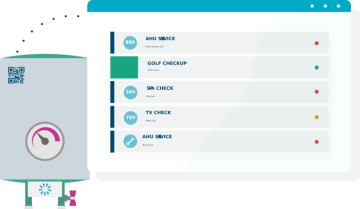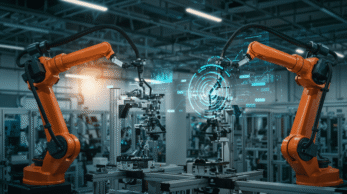Artificial intelligence is emerging as a powerhouse for preventive maintenance, especially when every second of technical downtime can result in substantial financial losses.
Gone are the days of chasing after breakdowns; AI opens the doors to a future where anticipation is synonymous with savings.
Is this a necessary path towards increased operational efficiency and enhanced competitiveness? It appears that in certain industry sectors, this transformation is more than a trend; it’s an imperative to remain relevant in an evolving industrial landscape.
This article dives into the stream of high technology, where AI is not just an aid but the linchpin of a silently efficient and decisively robust industrial revolution. Embark on the heart of tomorrow’s maintenance strategy.
The evolution of maintenance: from reactive to proactive

From corrective maintenance to preventive maintenance
Historically, corrective maintenance was the standard: machines were used until they broke down, and repairs were done after the fact. Although simple, this method is costly in terms of unexpected downtime and major repairs. With the advent of new technologies and a better understanding of the economic impacts of unplanned outages, industries began to embrace preventive maintenance strategies.
Preventive maintenance involves carrying out regular, planned interventions, based not only on time intervals but also on performance analysis and the operational state of equipment. This approach is designed to preempt failures before they occur, relying on regular inspections, testing, measurements, adjustments, and cleaning, which can help extend the lifespan of equipment and maintain its efficiency.
Key figures on the impact of preventive actions
The adoption of preventive maintenance brings significant benefits. According to a study by the Federal Energy Management Program (FEMP), implementing preventive maintenance can lead to a 12 to 18% reduction in maintenance costs compared to a corrective approach. Moreover, it helps reduce unplanned downtime, which is often much costlier than scheduled interventions. A report by the U.S. Department of Energy indicates that preventive maintenance can improve equipment reliability by 35 to 45% and reduce breakdowns by 70 to 75%.
Companies that adopt this strategy not only improve their equipment’s longevity but also competitively position themselves by minimizing unexpected interruptions, which can have a direct impact on their profitability.
Artificial Intelligence at the heart of maintenance strategy
Real-time analysis: how does AI transform monitoring?
The use of AI for real-time equipment monitoring represents a major shift towards more proactive maintenance. AI technologies, especially machine learning and predictive analytics, enable the analysis of massive volumes of operational data in real-time. The ability to process and interpret data from machine-integrated sensors provides a clear and anticipatory vision of equipment health. For example, AI algorithms can detect subtle anomalies in machine behavior that often precede breakdowns. This allows for targeted interventions well before problems become critical, thus reducing the risks of unexpected and costly outages.
Customization and precision: how does Artificial Intelligence improve maintenance operations?
AI doesn’t just enhance monitoring; it also allows for significant customization and precision in maintenance programs. Each machine can have a unique wear pattern, influenced by factors like its operating environment, age, and specific usage conditions. AI systems are capable of learning these peculiarities and adjusting maintenance strategies for each piece of equipment individually. This customization not only leads to more effective maintenance but also to resource optimization, as interventions are precisely tailored to the actual needs of each machine, avoiding overuse or underutilization of vital components.
Integrating AI into maintenance strategies is no longer a futuristic trend but an operational reality that is transforming the industrial landscape, making processes not only more efficient but also more resilient. By relying on AI, companies can not only anticipate potential problems but also proactively resolve them, ensuring continuous operation while maintaining high-performance levels.
Implementing Artificial Intelligence to optimize preventive maintenance
With a strategic framework in place, deploying artificial intelligence in preventive maintenance requires methodical steps for successful integration. This process is not limited to installing advanced technologies; it involves a profound cultural and organizational transformation.
Key steps in the integration of AI into maintenance processes
- Establishing a solid data ecosystem. Historical and real-time machine data must be integrated into a centralized platform. This often requires advanced sensors and IoT (Internet of Things) systems that can collect accurate and continuous information.
- Verification of data quality. Rigorous data cleaning and validation are vital to avoid feeding AI models with incorrect information that could lead to wrong diagnoses.
- Developing machine learning and predictive analytics models. Building these models must be done in close collaboration with maintenance experts to ensure the outcomes are relevant and applicable. These models are then trained with collected data, adjusted, and validated through iterative cycles to refine their accuracy.
Successful use cases and lessons learned
Leading companies in the energy, manufacturing, and transportation sectors have already made significant advances by integrating AI into their maintenance. For instance, in the energy industry, companies use predictive models to anticipate gas turbine failures, allowing planned maintenance that avoids costly and unplanned shutdowns.
Several lessons can be gleaned from these successes.
- Stakeholders must be engaged at all levels of the organization to overcome resistance to change and embrace new technologies.
- Technical staff require continuous training on AI tools and best practices in predictive maintenance to maintain the system’s effectiveness.
- The adaptability of AI models is crucial; they must be regularly updated to reflect changes in operational conditions or new insights.
Expert opinion
And concretely, what is the role of DimoMaint CMMS?
The interoperability of DimoMaint CMMS allows receiving a maintenance request or a work order from an IoT sensor, a BMS/EMS, a MES, or a predictive AI module based on well-thought-out measurement correlations. The CMMS becomes the receptacle of alerts or deviations.
Sébastien LATOUR, Product Range Manager, DimoMaint.
The integration of artificial intelligence into preventive maintenance strategies is not an end in itself, but a dynamic means of enhancing the resilience and efficiency of industrial operations. By harnessing the power of AI, companies can not only foresee and prevent equipment failures but also optimize maintenance cycles and reduce operational costs. Advances in AI offer unprecedented opportunities for maintenance managers eager to overhaul their operations and secure long-lasting performance in an increasingly competitive market.




